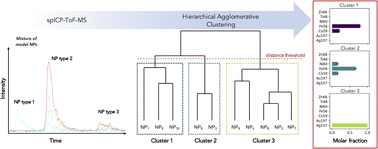Themed collection Fast Transient Signals – Getting the most out of Multidimensional Data

Improved single particle ICP-MS assessment using a novel Python-based data processing algorithm (Sparta) for nanoparticle quantification
The novel Python-based spICP-MS data processing algorithm ‘Sparta’ is presented and benchmarked against existing software for characterising nanoparticles (NPs) in terms of element-specific mass, size, and particle number concentration (PNC).

J. Anal. At. Spectrom., 2026, Advance Article
https://doi.org/10.1039/D5JA00285K
Single particle inductively coupled plasma mass spectrometry for the characterization of colloidal particles in soils, sediments and sludges: comparative study of sector field and time-of-flight instruments
Combined use of single-particle inductively coupled plasma sector field mass spectrometry (SP-ICP-SF-MS) and single particle inductively coupled plasma time-of-flight mass spectrometry (SP-ICP-ToF-MS) provides insights into solid phase samples.

J. Anal. At. Spectrom., 2025,40, 2487-2497
https://doi.org/10.1039/D5JA00181A
Self-organizing maps for the detection and classification of natural nanoparticles, nanoparticle systems and engineered nanoparticles characterized using single particle ICP-time-of-flight-MS
After demonstrating the effectiveness of self-organizing maps for detecting particles in spICP-ToF-MS time-series, and for characterizing and comparing natural nanoparticle systems, algorithms, a tutorial, and test data are provided.

J. Anal. At. Spectrom., 2025,40, 2471-2486
https://doi.org/10.1039/D5JA00179J
Quantification of laser-induced aerosols by microdroplet calibration and investigation of matrix effects using LA-ICP-TOFMS
Dual sample introduction of laser-induced aerosols and monodisperse microdroplets into an ICP-TOFMS enabled accurate quantification across inorganic and proteinaceous matrices.

J. Anal. At. Spectrom., 2025,40, 2438-2446
https://doi.org/10.1039/D5JA00171D
Evaluation of laser-induced and ICP-induced elemental fractionation using laser ablation-ICP-TOFMS
This study evaluates the fractionation effects caused by the laser ablation process and ICP-induced fractionation by determining the relative differences in crater formation and the deposited material remaining on the sample surface.

J. Anal. At. Spectrom., 2025,40, 2408-2417
https://doi.org/10.1039/D5JA00173K
AutoSpect: an all-in-one software solution for automated processing of LA-ICP-TOF-MS datasets
AutoSpect software workflow and snapshots of the software functionalities are outlined.

J. Anal. At. Spectrom., 2025,40, 2162-2178
https://doi.org/10.1039/D5JA00145E
Single-particle isotope ratio analysis of lanthanide-doped microplastics using inductively coupled plasma time-of-flight mass spectrometry
Accuracy and precision of isotope ratio analysis in single particles improved using ICP-TOF-MS with collision cell technology.

J. Anal. At. Spectrom., 2025,40, 1718-1725
https://doi.org/10.1039/D5JA00125K
Determination of the uptake of lanthanide doped-carbon dots by human cells using single cell ICP-ToF-MS
A multi-modal metrological approach for the quantification of lanthanide doped carbon dots (Eu and Yb) uptaken by HeLa cells using sc-ICP-ToF-MS.

J. Anal. At. Spectrom., 2025,40, 1403-1410
https://doi.org/10.1039/D5JA00075K
TOFHunter—unlocking rapid untargeted screening of inductively coupled plasma–time-of-flight–mass spectrometry data
This study provides an overview of a newly developed program written in Python, TOFHunter, which permits the rapid and untargeted screening of inductively coupled plasma (ICP)-time-of-flight (TOF)-mass spectrometry (MS) datasets.

J. Anal. At. Spectrom., 2025,40, 910-920
https://doi.org/10.1039/D4JA00331D
Challenges in measuring nanoparticles and microparticles by single particle ICP-QMS and ICP-TOFMS: size-dependent transport efficiency and limited linear dynamic range
The transport efficiency of microparticles larger than ∼700 nm decreases with size. While SiO2 particles as large as 5 µm are completely vaporized in the ICP, the ion detection system limited linear dynamic range will often require signal reduction.

J. Anal. At. Spectrom., 2025,40, 848-859
https://doi.org/10.1039/D4JA00425F
SPCal – an open source, easy-to-use processing platform for ICP-TOFMS-based single event data
SPCal is a comprehensive data processing platform for single event ICP-MS data. It supports the analysis of both quadrupole and TOF data sets. Various tools (e.g., non-target screening, compositional and conditional analysis) are implemented.

J. Anal. At. Spectrom., 2025,40, 130-136
https://doi.org/10.1039/D4JA00241E
Machine learning analysis to classify nanoparticles from noisy spICP-TOFMS data
A two-stage semi-supervised machine learning approach was developed as a robust method to classify cerium-rich engineered, incidental, and natural nanoparticles measured by spICP-TOFMS.

J. Anal. At. Spectrom., 2023,38, 1244-1252
https://doi.org/10.1039/D3JA00081H
Nanoparticle identification using single particle ICP-ToF-MS acquisition coupled to cluster analysis. From engineered to natural nanoparticles
Characterization and identification of multielement nanoparticles thanks to the use of a spICP-ToF-MS coupled to hierarchical agglomerative clustering (HAC).

J. Anal. At. Spectrom., 2022,37, 2042-2052
https://doi.org/10.1039/D2JA00116K
Machine learning: our future spotlight into single-particle ICP-ToF-MS analysis
Using the multi-element capabilities of single-particle ICP-ToF-MS in combination with a laser ablation and machine learning algorithms, environmentally relevant road runoff samples were characterized.

J. Anal. At. Spectrom., 2021,36, 2684-2694
https://doi.org/10.1039/D1JA00213A
Two-stage semi-supervised machine learning for classification of Ti-rich nanoparticles and microparticles measured by spICP-TOFMS
An application of two-stage SSML model to classify individual Ti-containing particles via spICP-TOFMS analysis. With two-stage SSML, we demonstrate low false-positive rates (≤5%) and moderate particle recoveries for all measured particle types.

J. Anal. At. Spectrom., 2025,40, 1658-1665
https://doi.org/10.1039/D5JA00108K
Introducing “time-of-flight single particle investigator” (TOF-SPI): a tool for quantitative spICP-TOFMS data analysis
TOF-SPI is software for accurate, robust, and high-throughput analysis of single-particle ICP-TOFMS data.

J. Anal. At. Spectrom., 2024,39, 704-711
https://doi.org/10.1039/D3JA00421J
About this collection
This collection consists of recently published and invited contributions that highlight strategies to maximise information extraction from multidimensional dataset generated from ICP-ToF-MS. The collection is Guest Edited by Björn Meermann (BAM, Germany), Lukas Schlatt (Nu Instruments Ltd, UK) and Lyndsey Hendriks (University of Vienna, Austria). The collection is now open to new submissions and new articles will be added as they are published.